BULAW5915: Corporate Law Assignment on Phoenix Activities Analysis
VerifiedAdded on 2020/02/23
|14
|3419
|218
Report
AI Summary
This report delves into the complex realm of phoenix activities within the framework of corporate law, focusing on the BULAW5915 course at Federation University. The assignment begins by defining phoenix activity, highlighting its detrimental impact on society, and exploring the various motivations behind such practices, including the evasion of liabilities. It examines the absence of a specific definition in the Corporations Act 2001 and the role of ASIC, including Regulatory Guide 242 and the Phoenixing Act amendments. The report further discusses the penalties for engaging in unlawful phoenix activities, referencing director duties under Part 2D.1, and sections 181, 182, 183, 206C, and 588G of the Corporations Act. A case study, ASIC v Somerville & Ors [2009] NSWSC 934, illustrates the legal consequences. Finally, it assesses the effectiveness of phoenix prohibitions, considering their potential impact on compliance and the challenges in drafting legislative provisions to address the issue effectively.
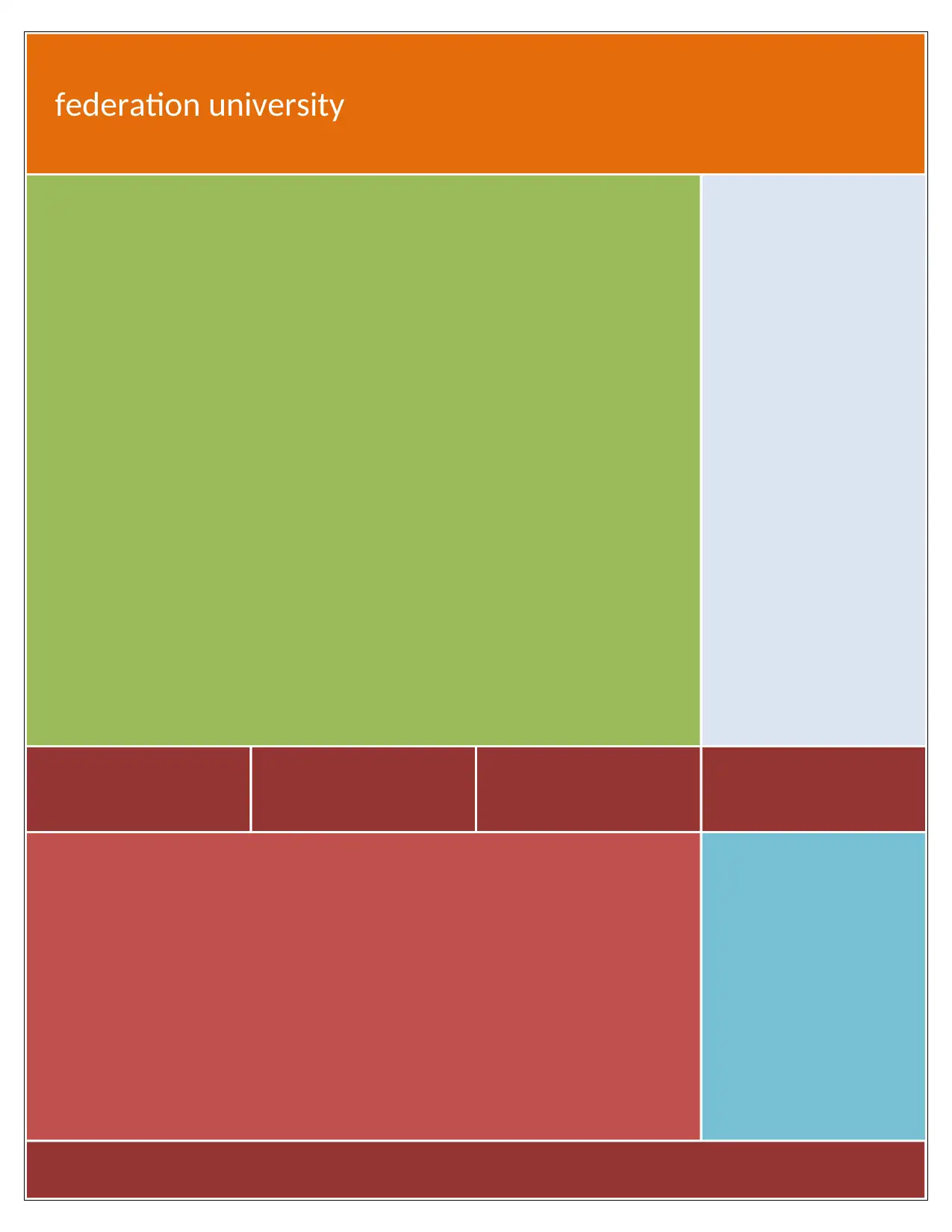
federation university
Paraphrase This Document
Need a fresh take? Get an instant paraphrase of this document with our AI Paraphraser

QUESTIONS 2
Contents
Part A...............................................................................................................................................3
Q. 1..............................................................................................................................................3
Q. 2..............................................................................................................................................3
Q. 3..............................................................................................................................................4
Q. 4..............................................................................................................................................4
Q. 5..............................................................................................................................................6
Q. 6..............................................................................................................................................6
Part B...............................................................................................................................................7
Q. 7..............................................................................................................................................7
Q. 8..............................................................................................................................................8
Q. 9............................................................................................................................................11
References......................................................................................................................................12
Contents
Part A...............................................................................................................................................3
Q. 1..............................................................................................................................................3
Q. 2..............................................................................................................................................3
Q. 3..............................................................................................................................................4
Q. 4..............................................................................................................................................4
Q. 5..............................................................................................................................................6
Q. 6..............................................................................................................................................6
Part B...............................................................................................................................................7
Q. 7..............................................................................................................................................7
Q. 8..............................................................................................................................................8
Q. 9............................................................................................................................................11
References......................................................................................................................................12
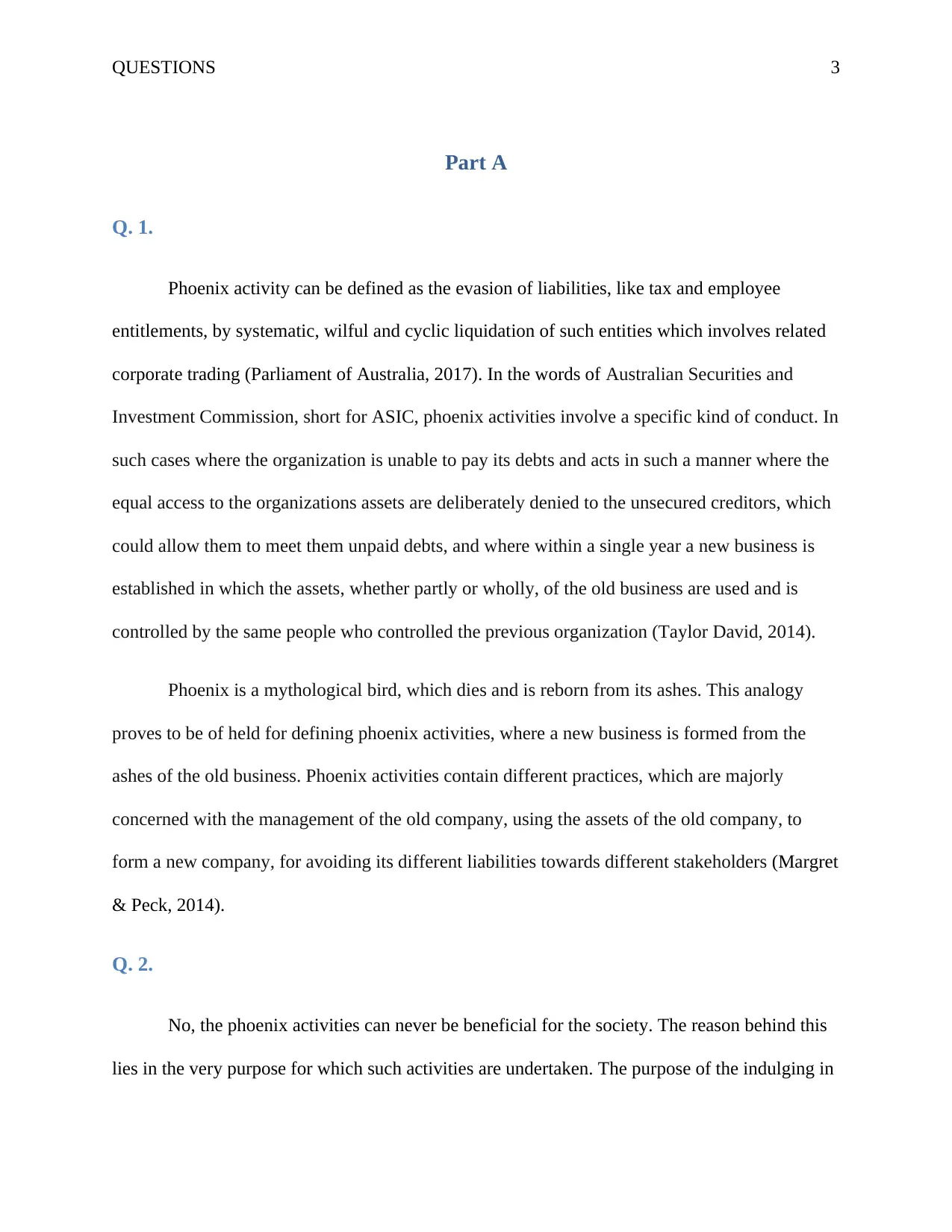
QUESTIONS 3
Part A
Q. 1.
Phoenix activity can be defined as the evasion of liabilities, like tax and employee
entitlements, by systematic, wilful and cyclic liquidation of such entities which involves related
corporate trading (Parliament of Australia, 2017). In the words of Australian Securities and
Investment Commission, short for ASIC, phoenix activities involve a specific kind of conduct. In
such cases where the organization is unable to pay its debts and acts in such a manner where the
equal access to the organizations assets are deliberately denied to the unsecured creditors, which
could allow them to meet them unpaid debts, and where within a single year a new business is
established in which the assets, whether partly or wholly, of the old business are used and is
controlled by the same people who controlled the previous organization (Taylor David, 2014).
Phoenix is a mythological bird, which dies and is reborn from its ashes. This analogy
proves to be of held for defining phoenix activities, where a new business is formed from the
ashes of the old business. Phoenix activities contain different practices, which are majorly
concerned with the management of the old company, using the assets of the old company, to
form a new company, for avoiding its different liabilities towards different stakeholders (Margret
& Peck, 2014).
Q. 2.
No, the phoenix activities can never be beneficial for the society. The reason behind this
lies in the very purpose for which such activities are undertaken. The purpose of the indulging in
Part A
Q. 1.
Phoenix activity can be defined as the evasion of liabilities, like tax and employee
entitlements, by systematic, wilful and cyclic liquidation of such entities which involves related
corporate trading (Parliament of Australia, 2017). In the words of Australian Securities and
Investment Commission, short for ASIC, phoenix activities involve a specific kind of conduct. In
such cases where the organization is unable to pay its debts and acts in such a manner where the
equal access to the organizations assets are deliberately denied to the unsecured creditors, which
could allow them to meet them unpaid debts, and where within a single year a new business is
established in which the assets, whether partly or wholly, of the old business are used and is
controlled by the same people who controlled the previous organization (Taylor David, 2014).
Phoenix is a mythological bird, which dies and is reborn from its ashes. This analogy
proves to be of held for defining phoenix activities, where a new business is formed from the
ashes of the old business. Phoenix activities contain different practices, which are majorly
concerned with the management of the old company, using the assets of the old company, to
form a new company, for avoiding its different liabilities towards different stakeholders (Margret
& Peck, 2014).
Q. 2.
No, the phoenix activities can never be beneficial for the society. The reason behind this
lies in the very purpose for which such activities are undertaken. The purpose of the indulging in
⊘ This is a preview!⊘
Do you want full access?
Subscribe today to unlock all pages.

Trusted by 1+ million students worldwide
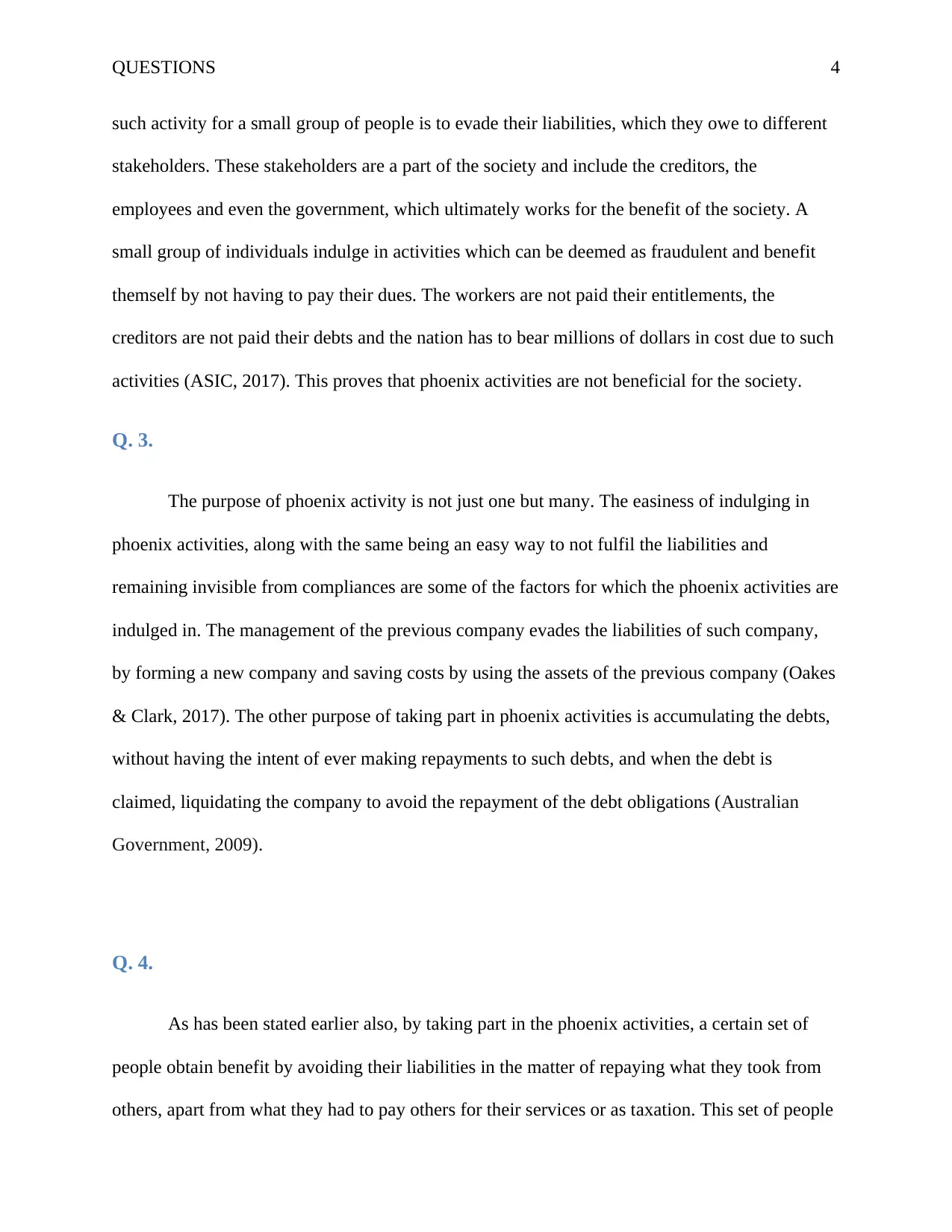
QUESTIONS 4
such activity for a small group of people is to evade their liabilities, which they owe to different
stakeholders. These stakeholders are a part of the society and include the creditors, the
employees and even the government, which ultimately works for the benefit of the society. A
small group of individuals indulge in activities which can be deemed as fraudulent and benefit
themself by not having to pay their dues. The workers are not paid their entitlements, the
creditors are not paid their debts and the nation has to bear millions of dollars in cost due to such
activities (ASIC, 2017). This proves that phoenix activities are not beneficial for the society.
Q. 3.
The purpose of phoenix activity is not just one but many. The easiness of indulging in
phoenix activities, along with the same being an easy way to not fulfil the liabilities and
remaining invisible from compliances are some of the factors for which the phoenix activities are
indulged in. The management of the previous company evades the liabilities of such company,
by forming a new company and saving costs by using the assets of the previous company (Oakes
& Clark, 2017). The other purpose of taking part in phoenix activities is accumulating the debts,
without having the intent of ever making repayments to such debts, and when the debt is
claimed, liquidating the company to avoid the repayment of the debt obligations (Australian
Government, 2009).
Q. 4.
As has been stated earlier also, by taking part in the phoenix activities, a certain set of
people obtain benefit by avoiding their liabilities in the matter of repaying what they took from
others, apart from what they had to pay others for their services or as taxation. This set of people
such activity for a small group of people is to evade their liabilities, which they owe to different
stakeholders. These stakeholders are a part of the society and include the creditors, the
employees and even the government, which ultimately works for the benefit of the society. A
small group of individuals indulge in activities which can be deemed as fraudulent and benefit
themself by not having to pay their dues. The workers are not paid their entitlements, the
creditors are not paid their debts and the nation has to bear millions of dollars in cost due to such
activities (ASIC, 2017). This proves that phoenix activities are not beneficial for the society.
Q. 3.
The purpose of phoenix activity is not just one but many. The easiness of indulging in
phoenix activities, along with the same being an easy way to not fulfil the liabilities and
remaining invisible from compliances are some of the factors for which the phoenix activities are
indulged in. The management of the previous company evades the liabilities of such company,
by forming a new company and saving costs by using the assets of the previous company (Oakes
& Clark, 2017). The other purpose of taking part in phoenix activities is accumulating the debts,
without having the intent of ever making repayments to such debts, and when the debt is
claimed, liquidating the company to avoid the repayment of the debt obligations (Australian
Government, 2009).
Q. 4.
As has been stated earlier also, by taking part in the phoenix activities, a certain set of
people obtain benefit by avoiding their liabilities in the matter of repaying what they took from
others, apart from what they had to pay others for their services or as taxation. This set of people
Paraphrase This Document
Need a fresh take? Get an instant paraphrase of this document with our AI Paraphraser
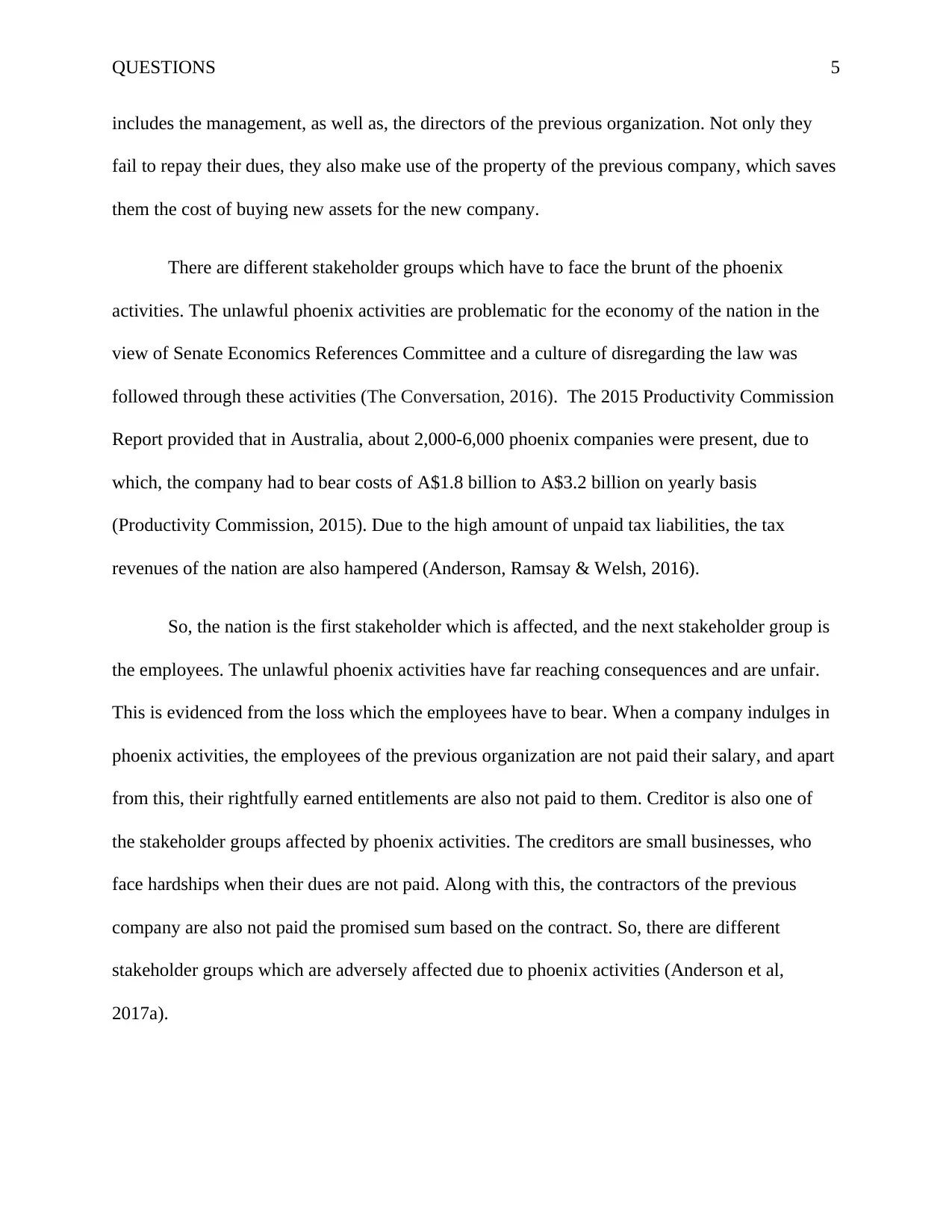
QUESTIONS 5
includes the management, as well as, the directors of the previous organization. Not only they
fail to repay their dues, they also make use of the property of the previous company, which saves
them the cost of buying new assets for the new company.
There are different stakeholder groups which have to face the brunt of the phoenix
activities. The unlawful phoenix activities are problematic for the economy of the nation in the
view of Senate Economics References Committee and a culture of disregarding the law was
followed through these activities (The Conversation, 2016). The 2015 Productivity Commission
Report provided that in Australia, about 2,000-6,000 phoenix companies were present, due to
which, the company had to bear costs of A$1.8 billion to A$3.2 billion on yearly basis
(Productivity Commission, 2015). Due to the high amount of unpaid tax liabilities, the tax
revenues of the nation are also hampered (Anderson, Ramsay & Welsh, 2016).
So, the nation is the first stakeholder which is affected, and the next stakeholder group is
the employees. The unlawful phoenix activities have far reaching consequences and are unfair.
This is evidenced from the loss which the employees have to bear. When a company indulges in
phoenix activities, the employees of the previous organization are not paid their salary, and apart
from this, their rightfully earned entitlements are also not paid to them. Creditor is also one of
the stakeholder groups affected by phoenix activities. The creditors are small businesses, who
face hardships when their dues are not paid. Along with this, the contractors of the previous
company are also not paid the promised sum based on the contract. So, there are different
stakeholder groups which are adversely affected due to phoenix activities (Anderson et al,
2017a).
includes the management, as well as, the directors of the previous organization. Not only they
fail to repay their dues, they also make use of the property of the previous company, which saves
them the cost of buying new assets for the new company.
There are different stakeholder groups which have to face the brunt of the phoenix
activities. The unlawful phoenix activities are problematic for the economy of the nation in the
view of Senate Economics References Committee and a culture of disregarding the law was
followed through these activities (The Conversation, 2016). The 2015 Productivity Commission
Report provided that in Australia, about 2,000-6,000 phoenix companies were present, due to
which, the company had to bear costs of A$1.8 billion to A$3.2 billion on yearly basis
(Productivity Commission, 2015). Due to the high amount of unpaid tax liabilities, the tax
revenues of the nation are also hampered (Anderson, Ramsay & Welsh, 2016).
So, the nation is the first stakeholder which is affected, and the next stakeholder group is
the employees. The unlawful phoenix activities have far reaching consequences and are unfair.
This is evidenced from the loss which the employees have to bear. When a company indulges in
phoenix activities, the employees of the previous organization are not paid their salary, and apart
from this, their rightfully earned entitlements are also not paid to them. Creditor is also one of
the stakeholder groups affected by phoenix activities. The creditors are small businesses, who
face hardships when their dues are not paid. Along with this, the contractors of the previous
company are also not paid the promised sum based on the contract. So, there are different
stakeholder groups which are adversely affected due to phoenix activities (Anderson et al,
2017a).
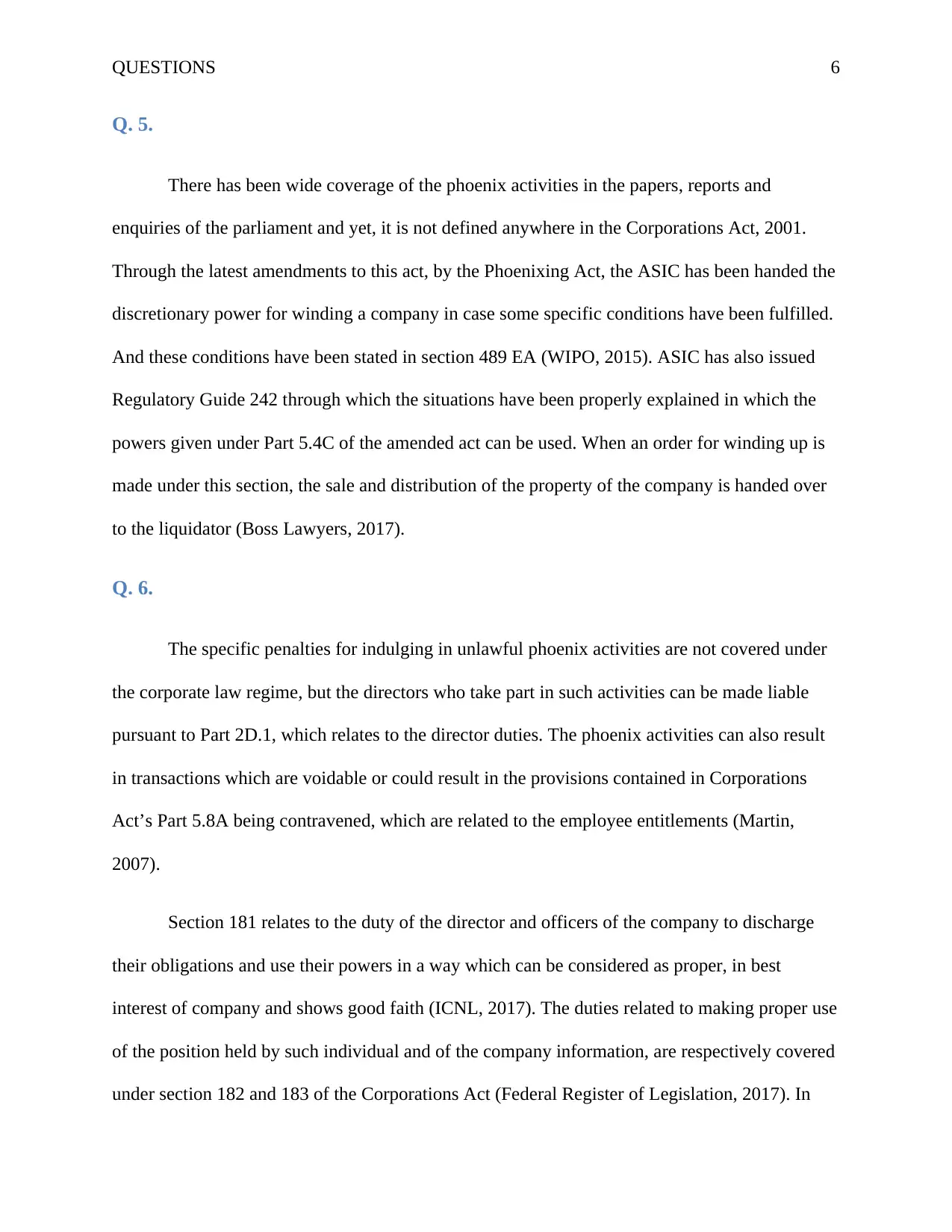
QUESTIONS 6
Q. 5.
There has been wide coverage of the phoenix activities in the papers, reports and
enquiries of the parliament and yet, it is not defined anywhere in the Corporations Act, 2001.
Through the latest amendments to this act, by the Phoenixing Act, the ASIC has been handed the
discretionary power for winding a company in case some specific conditions have been fulfilled.
And these conditions have been stated in section 489 EA (WIPO, 2015). ASIC has also issued
Regulatory Guide 242 through which the situations have been properly explained in which the
powers given under Part 5.4C of the amended act can be used. When an order for winding up is
made under this section, the sale and distribution of the property of the company is handed over
to the liquidator (Boss Lawyers, 2017).
Q. 6.
The specific penalties for indulging in unlawful phoenix activities are not covered under
the corporate law regime, but the directors who take part in such activities can be made liable
pursuant to Part 2D.1, which relates to the director duties. The phoenix activities can also result
in transactions which are voidable or could result in the provisions contained in Corporations
Act’s Part 5.8A being contravened, which are related to the employee entitlements (Martin,
2007).
Section 181 relates to the duty of the director and officers of the company to discharge
their obligations and use their powers in a way which can be considered as proper, in best
interest of company and shows good faith (ICNL, 2017). The duties related to making proper use
of the position held by such individual and of the company information, are respectively covered
under section 182 and 183 of the Corporations Act (Federal Register of Legislation, 2017). In
Q. 5.
There has been wide coverage of the phoenix activities in the papers, reports and
enquiries of the parliament and yet, it is not defined anywhere in the Corporations Act, 2001.
Through the latest amendments to this act, by the Phoenixing Act, the ASIC has been handed the
discretionary power for winding a company in case some specific conditions have been fulfilled.
And these conditions have been stated in section 489 EA (WIPO, 2015). ASIC has also issued
Regulatory Guide 242 through which the situations have been properly explained in which the
powers given under Part 5.4C of the amended act can be used. When an order for winding up is
made under this section, the sale and distribution of the property of the company is handed over
to the liquidator (Boss Lawyers, 2017).
Q. 6.
The specific penalties for indulging in unlawful phoenix activities are not covered under
the corporate law regime, but the directors who take part in such activities can be made liable
pursuant to Part 2D.1, which relates to the director duties. The phoenix activities can also result
in transactions which are voidable or could result in the provisions contained in Corporations
Act’s Part 5.8A being contravened, which are related to the employee entitlements (Martin,
2007).
Section 181 relates to the duty of the director and officers of the company to discharge
their obligations and use their powers in a way which can be considered as proper, in best
interest of company and shows good faith (ICNL, 2017). The duties related to making proper use
of the position held by such individual and of the company information, are respectively covered
under section 182 and 183 of the Corporations Act (Federal Register of Legislation, 2017). In
⊘ This is a preview!⊘
Do you want full access?
Subscribe today to unlock all pages.

Trusted by 1+ million students worldwide
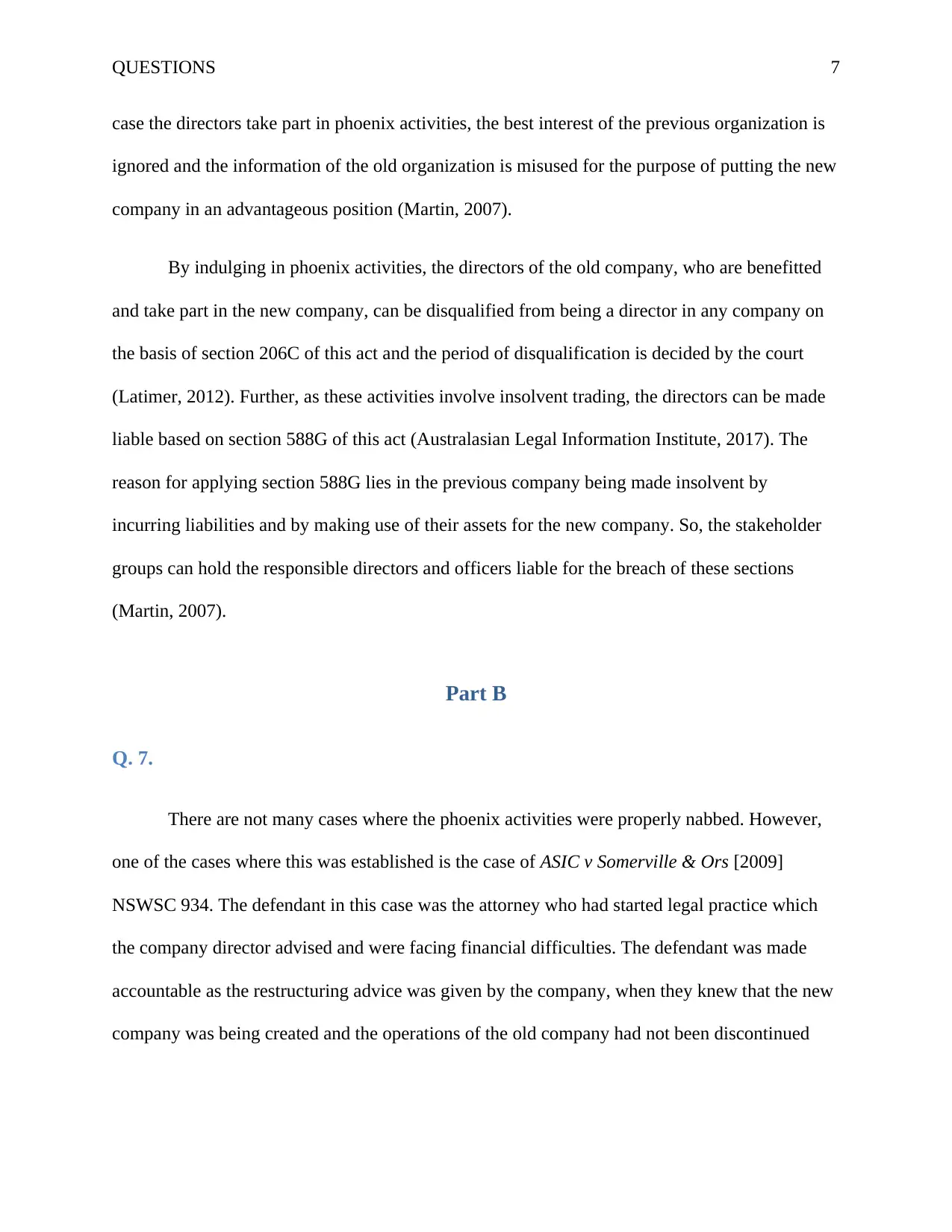
QUESTIONS 7
case the directors take part in phoenix activities, the best interest of the previous organization is
ignored and the information of the old organization is misused for the purpose of putting the new
company in an advantageous position (Martin, 2007).
By indulging in phoenix activities, the directors of the old company, who are benefitted
and take part in the new company, can be disqualified from being a director in any company on
the basis of section 206C of this act and the period of disqualification is decided by the court
(Latimer, 2012). Further, as these activities involve insolvent trading, the directors can be made
liable based on section 588G of this act (Australasian Legal Information Institute, 2017). The
reason for applying section 588G lies in the previous company being made insolvent by
incurring liabilities and by making use of their assets for the new company. So, the stakeholder
groups can hold the responsible directors and officers liable for the breach of these sections
(Martin, 2007).
Part B
Q. 7.
There are not many cases where the phoenix activities were properly nabbed. However,
one of the cases where this was established is the case of ASIC v Somerville & Ors [2009]
NSWSC 934. The defendant in this case was the attorney who had started legal practice which
the company director advised and were facing financial difficulties. The defendant was made
accountable as the restructuring advice was given by the company, when they knew that the new
company was being created and the operations of the old company had not been discontinued
case the directors take part in phoenix activities, the best interest of the previous organization is
ignored and the information of the old organization is misused for the purpose of putting the new
company in an advantageous position (Martin, 2007).
By indulging in phoenix activities, the directors of the old company, who are benefitted
and take part in the new company, can be disqualified from being a director in any company on
the basis of section 206C of this act and the period of disqualification is decided by the court
(Latimer, 2012). Further, as these activities involve insolvent trading, the directors can be made
liable based on section 588G of this act (Australasian Legal Information Institute, 2017). The
reason for applying section 588G lies in the previous company being made insolvent by
incurring liabilities and by making use of their assets for the new company. So, the stakeholder
groups can hold the responsible directors and officers liable for the breach of these sections
(Martin, 2007).
Part B
Q. 7.
There are not many cases where the phoenix activities were properly nabbed. However,
one of the cases where this was established is the case of ASIC v Somerville & Ors [2009]
NSWSC 934. The defendant in this case was the attorney who had started legal practice which
the company director advised and were facing financial difficulties. The defendant was made
accountable as the restructuring advice was given by the company, when they knew that the new
company was being created and the operations of the old company had not been discontinued
Paraphrase This Document
Need a fresh take? Get an instant paraphrase of this document with our AI Paraphraser
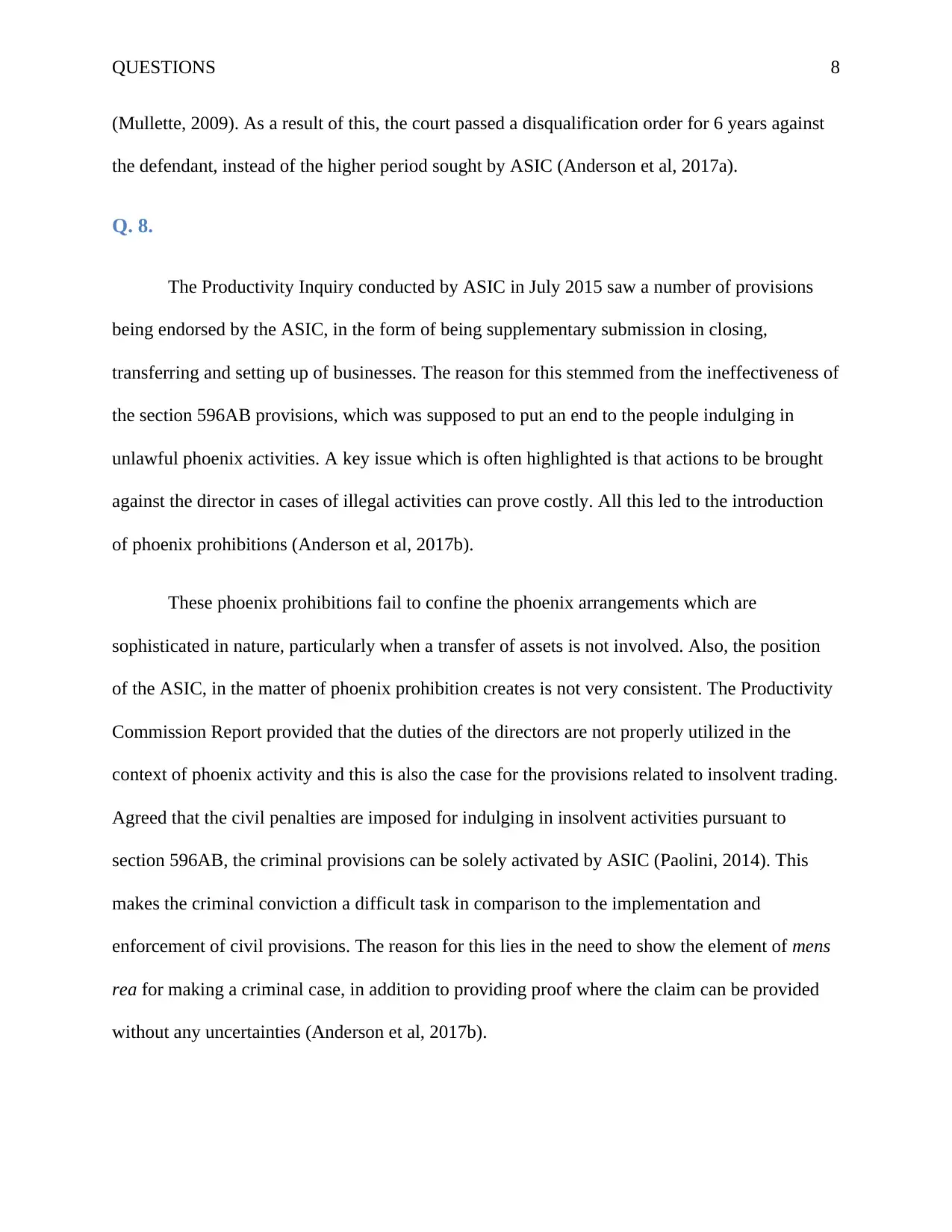
QUESTIONS 8
(Mullette, 2009). As a result of this, the court passed a disqualification order for 6 years against
the defendant, instead of the higher period sought by ASIC (Anderson et al, 2017a).
Q. 8.
The Productivity Inquiry conducted by ASIC in July 2015 saw a number of provisions
being endorsed by the ASIC, in the form of being supplementary submission in closing,
transferring and setting up of businesses. The reason for this stemmed from the ineffectiveness of
the section 596AB provisions, which was supposed to put an end to the people indulging in
unlawful phoenix activities. A key issue which is often highlighted is that actions to be brought
against the director in cases of illegal activities can prove costly. All this led to the introduction
of phoenix prohibitions (Anderson et al, 2017b).
These phoenix prohibitions fail to confine the phoenix arrangements which are
sophisticated in nature, particularly when a transfer of assets is not involved. Also, the position
of the ASIC, in the matter of phoenix prohibition creates is not very consistent. The Productivity
Commission Report provided that the duties of the directors are not properly utilized in the
context of phoenix activity and this is also the case for the provisions related to insolvent trading.
Agreed that the civil penalties are imposed for indulging in insolvent activities pursuant to
section 596AB, the criminal provisions can be solely activated by ASIC (Paolini, 2014). This
makes the criminal conviction a difficult task in comparison to the implementation and
enforcement of civil provisions. The reason for this lies in the need to show the element of mens
rea for making a criminal case, in addition to providing proof where the claim can be provided
without any uncertainties (Anderson et al, 2017b).
(Mullette, 2009). As a result of this, the court passed a disqualification order for 6 years against
the defendant, instead of the higher period sought by ASIC (Anderson et al, 2017a).
Q. 8.
The Productivity Inquiry conducted by ASIC in July 2015 saw a number of provisions
being endorsed by the ASIC, in the form of being supplementary submission in closing,
transferring and setting up of businesses. The reason for this stemmed from the ineffectiveness of
the section 596AB provisions, which was supposed to put an end to the people indulging in
unlawful phoenix activities. A key issue which is often highlighted is that actions to be brought
against the director in cases of illegal activities can prove costly. All this led to the introduction
of phoenix prohibitions (Anderson et al, 2017b).
These phoenix prohibitions fail to confine the phoenix arrangements which are
sophisticated in nature, particularly when a transfer of assets is not involved. Also, the position
of the ASIC, in the matter of phoenix prohibition creates is not very consistent. The Productivity
Commission Report provided that the duties of the directors are not properly utilized in the
context of phoenix activity and this is also the case for the provisions related to insolvent trading.
Agreed that the civil penalties are imposed for indulging in insolvent activities pursuant to
section 596AB, the criminal provisions can be solely activated by ASIC (Paolini, 2014). This
makes the criminal conviction a difficult task in comparison to the implementation and
enforcement of civil provisions. The reason for this lies in the need to show the element of mens
rea for making a criminal case, in addition to providing proof where the claim can be provided
without any uncertainties (Anderson et al, 2017b).
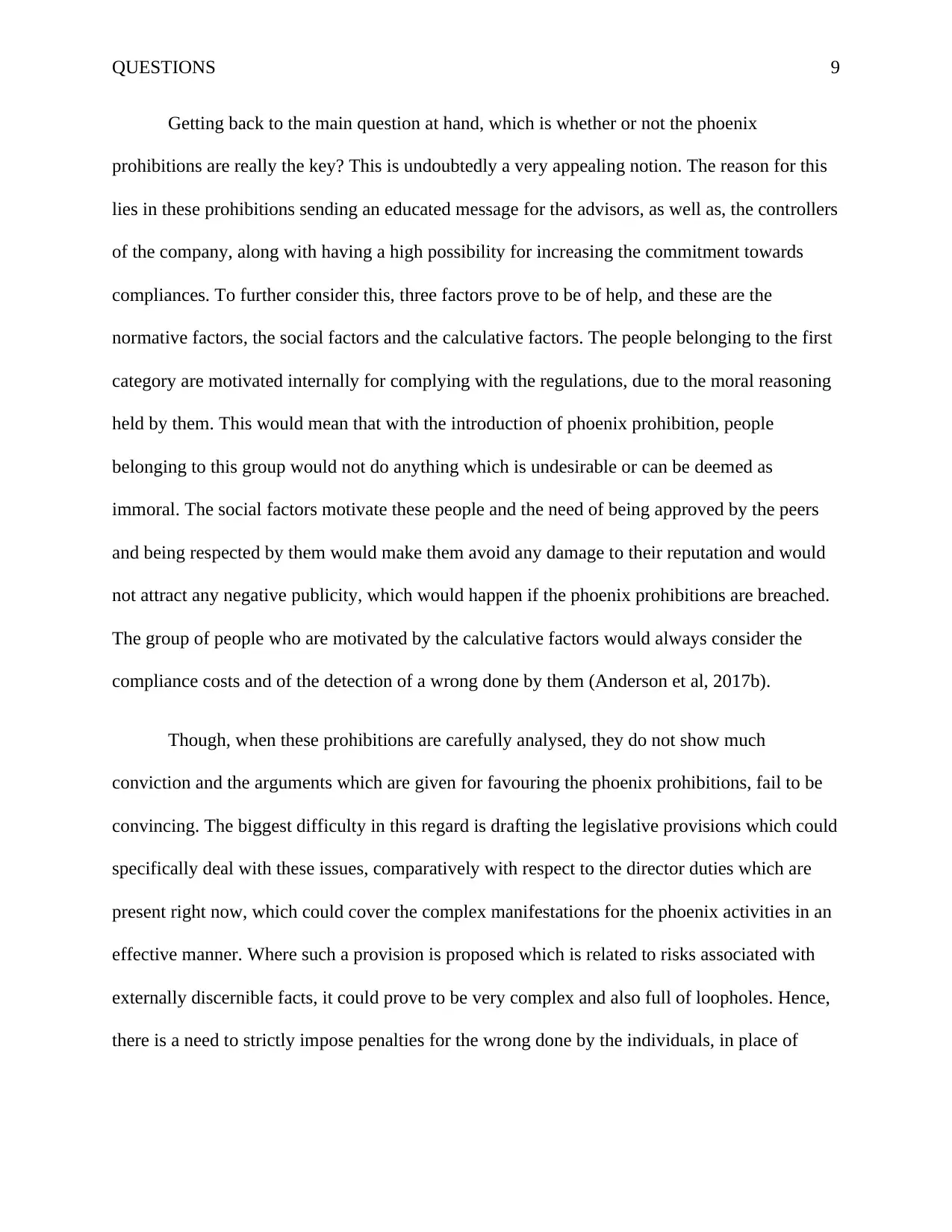
QUESTIONS 9
Getting back to the main question at hand, which is whether or not the phoenix
prohibitions are really the key? This is undoubtedly a very appealing notion. The reason for this
lies in these prohibitions sending an educated message for the advisors, as well as, the controllers
of the company, along with having a high possibility for increasing the commitment towards
compliances. To further consider this, three factors prove to be of help, and these are the
normative factors, the social factors and the calculative factors. The people belonging to the first
category are motivated internally for complying with the regulations, due to the moral reasoning
held by them. This would mean that with the introduction of phoenix prohibition, people
belonging to this group would not do anything which is undesirable or can be deemed as
immoral. The social factors motivate these people and the need of being approved by the peers
and being respected by them would make them avoid any damage to their reputation and would
not attract any negative publicity, which would happen if the phoenix prohibitions are breached.
The group of people who are motivated by the calculative factors would always consider the
compliance costs and of the detection of a wrong done by them (Anderson et al, 2017b).
Though, when these prohibitions are carefully analysed, they do not show much
conviction and the arguments which are given for favouring the phoenix prohibitions, fail to be
convincing. The biggest difficulty in this regard is drafting the legislative provisions which could
specifically deal with these issues, comparatively with respect to the director duties which are
present right now, which could cover the complex manifestations for the phoenix activities in an
effective manner. Where such a provision is proposed which is related to risks associated with
externally discernible facts, it could prove to be very complex and also full of loopholes. Hence,
there is a need to strictly impose penalties for the wrong done by the individuals, in place of
Getting back to the main question at hand, which is whether or not the phoenix
prohibitions are really the key? This is undoubtedly a very appealing notion. The reason for this
lies in these prohibitions sending an educated message for the advisors, as well as, the controllers
of the company, along with having a high possibility for increasing the commitment towards
compliances. To further consider this, three factors prove to be of help, and these are the
normative factors, the social factors and the calculative factors. The people belonging to the first
category are motivated internally for complying with the regulations, due to the moral reasoning
held by them. This would mean that with the introduction of phoenix prohibition, people
belonging to this group would not do anything which is undesirable or can be deemed as
immoral. The social factors motivate these people and the need of being approved by the peers
and being respected by them would make them avoid any damage to their reputation and would
not attract any negative publicity, which would happen if the phoenix prohibitions are breached.
The group of people who are motivated by the calculative factors would always consider the
compliance costs and of the detection of a wrong done by them (Anderson et al, 2017b).
Though, when these prohibitions are carefully analysed, they do not show much
conviction and the arguments which are given for favouring the phoenix prohibitions, fail to be
convincing. The biggest difficulty in this regard is drafting the legislative provisions which could
specifically deal with these issues, comparatively with respect to the director duties which are
present right now, which could cover the complex manifestations for the phoenix activities in an
effective manner. Where such a provision is proposed which is related to risks associated with
externally discernible facts, it could prove to be very complex and also full of loopholes. Hence,
there is a need to strictly impose penalties for the wrong done by the individuals, in place of
⊘ This is a preview!⊘
Do you want full access?
Subscribe today to unlock all pages.

Trusted by 1+ million students worldwide
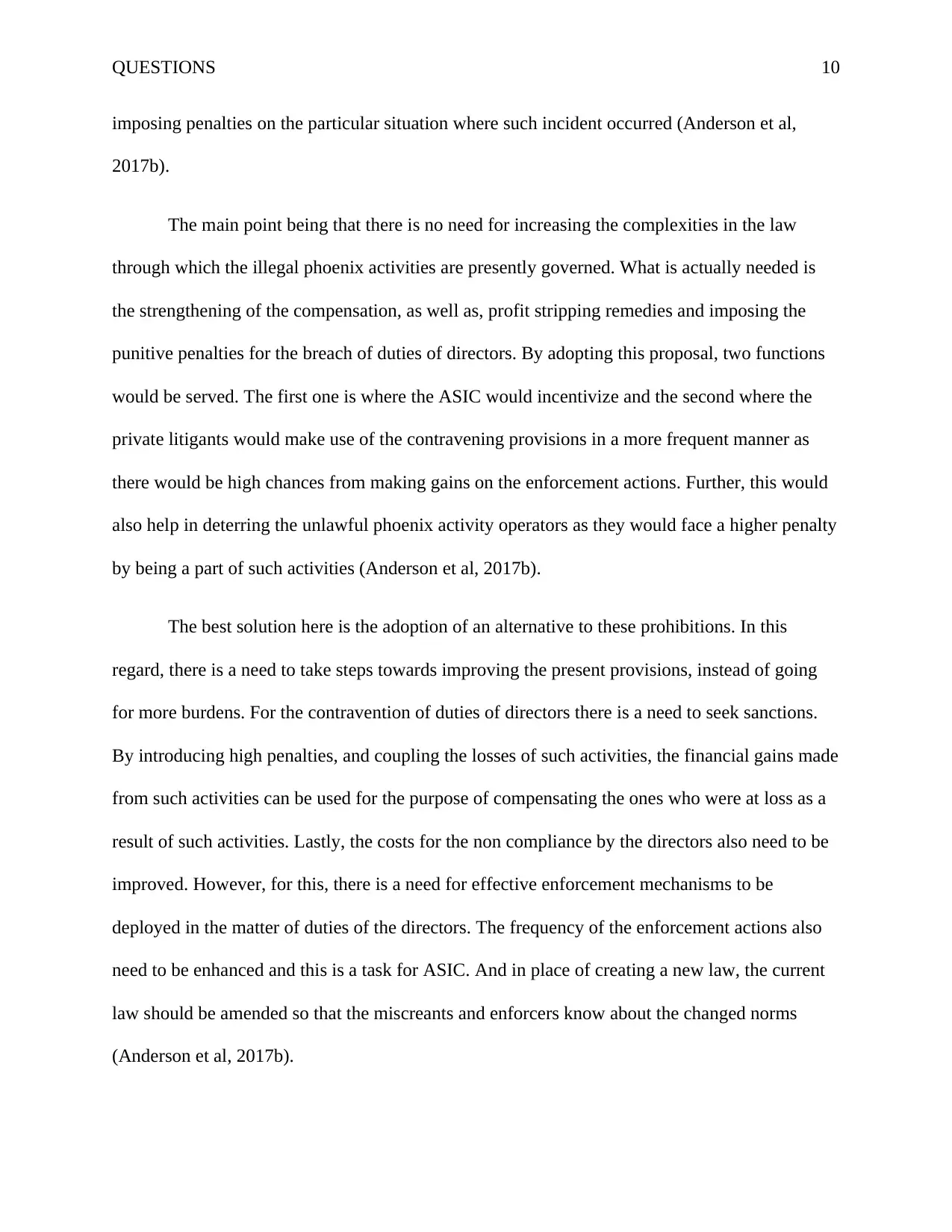
QUESTIONS 10
imposing penalties on the particular situation where such incident occurred (Anderson et al,
2017b).
The main point being that there is no need for increasing the complexities in the law
through which the illegal phoenix activities are presently governed. What is actually needed is
the strengthening of the compensation, as well as, profit stripping remedies and imposing the
punitive penalties for the breach of duties of directors. By adopting this proposal, two functions
would be served. The first one is where the ASIC would incentivize and the second where the
private litigants would make use of the contravening provisions in a more frequent manner as
there would be high chances from making gains on the enforcement actions. Further, this would
also help in deterring the unlawful phoenix activity operators as they would face a higher penalty
by being a part of such activities (Anderson et al, 2017b).
The best solution here is the adoption of an alternative to these prohibitions. In this
regard, there is a need to take steps towards improving the present provisions, instead of going
for more burdens. For the contravention of duties of directors there is a need to seek sanctions.
By introducing high penalties, and coupling the losses of such activities, the financial gains made
from such activities can be used for the purpose of compensating the ones who were at loss as a
result of such activities. Lastly, the costs for the non compliance by the directors also need to be
improved. However, for this, there is a need for effective enforcement mechanisms to be
deployed in the matter of duties of the directors. The frequency of the enforcement actions also
need to be enhanced and this is a task for ASIC. And in place of creating a new law, the current
law should be amended so that the miscreants and enforcers know about the changed norms
(Anderson et al, 2017b).
imposing penalties on the particular situation where such incident occurred (Anderson et al,
2017b).
The main point being that there is no need for increasing the complexities in the law
through which the illegal phoenix activities are presently governed. What is actually needed is
the strengthening of the compensation, as well as, profit stripping remedies and imposing the
punitive penalties for the breach of duties of directors. By adopting this proposal, two functions
would be served. The first one is where the ASIC would incentivize and the second where the
private litigants would make use of the contravening provisions in a more frequent manner as
there would be high chances from making gains on the enforcement actions. Further, this would
also help in deterring the unlawful phoenix activity operators as they would face a higher penalty
by being a part of such activities (Anderson et al, 2017b).
The best solution here is the adoption of an alternative to these prohibitions. In this
regard, there is a need to take steps towards improving the present provisions, instead of going
for more burdens. For the contravention of duties of directors there is a need to seek sanctions.
By introducing high penalties, and coupling the losses of such activities, the financial gains made
from such activities can be used for the purpose of compensating the ones who were at loss as a
result of such activities. Lastly, the costs for the non compliance by the directors also need to be
improved. However, for this, there is a need for effective enforcement mechanisms to be
deployed in the matter of duties of the directors. The frequency of the enforcement actions also
need to be enhanced and this is a task for ASIC. And in place of creating a new law, the current
law should be amended so that the miscreants and enforcers know about the changed norms
(Anderson et al, 2017b).
Paraphrase This Document
Need a fresh take? Get an instant paraphrase of this document with our AI Paraphraser
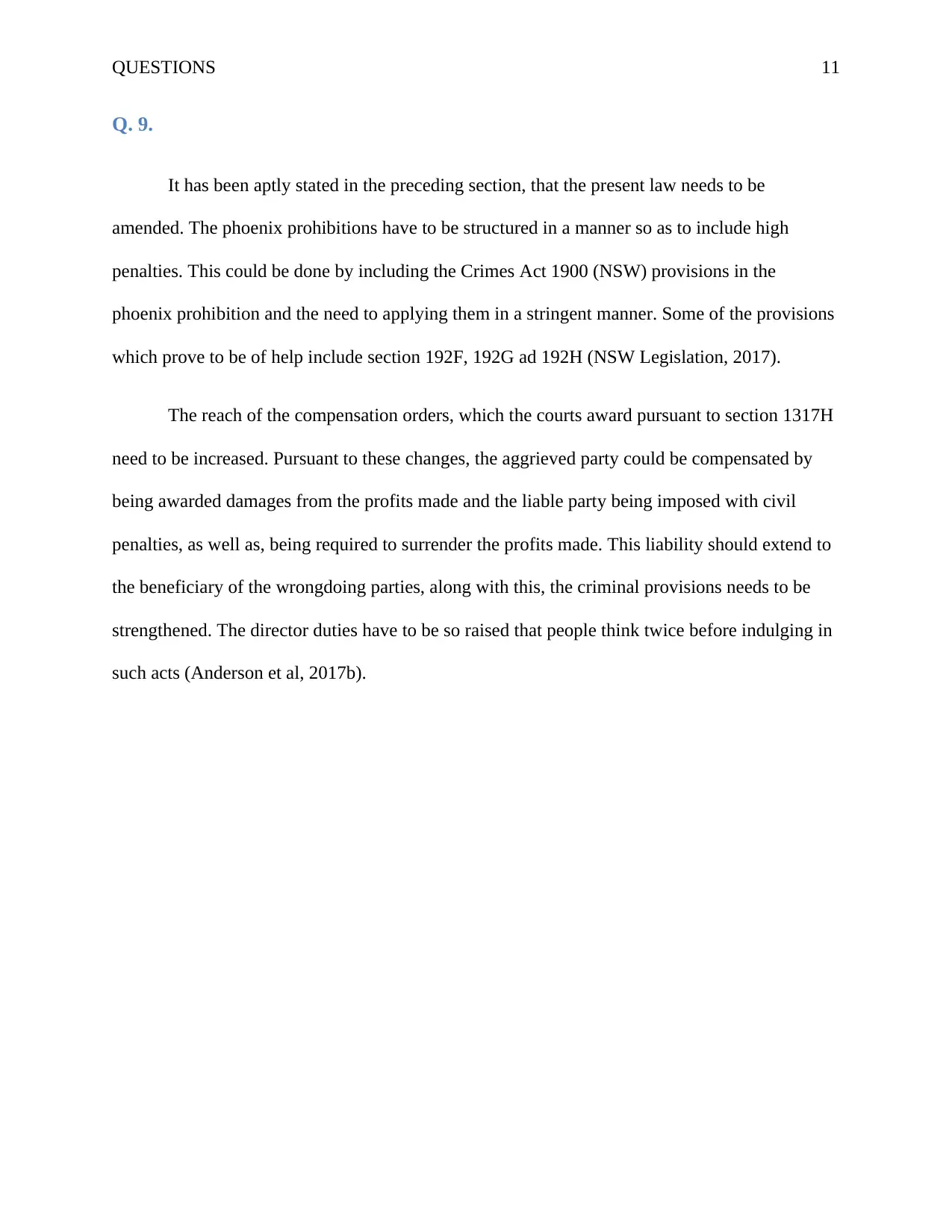
QUESTIONS 11
Q. 9.
It has been aptly stated in the preceding section, that the present law needs to be
amended. The phoenix prohibitions have to be structured in a manner so as to include high
penalties. This could be done by including the Crimes Act 1900 (NSW) provisions in the
phoenix prohibition and the need to applying them in a stringent manner. Some of the provisions
which prove to be of help include section 192F, 192G ad 192H (NSW Legislation, 2017).
The reach of the compensation orders, which the courts award pursuant to section 1317H
need to be increased. Pursuant to these changes, the aggrieved party could be compensated by
being awarded damages from the profits made and the liable party being imposed with civil
penalties, as well as, being required to surrender the profits made. This liability should extend to
the beneficiary of the wrongdoing parties, along with this, the criminal provisions needs to be
strengthened. The director duties have to be so raised that people think twice before indulging in
such acts (Anderson et al, 2017b).
Q. 9.
It has been aptly stated in the preceding section, that the present law needs to be
amended. The phoenix prohibitions have to be structured in a manner so as to include high
penalties. This could be done by including the Crimes Act 1900 (NSW) provisions in the
phoenix prohibition and the need to applying them in a stringent manner. Some of the provisions
which prove to be of help include section 192F, 192G ad 192H (NSW Legislation, 2017).
The reach of the compensation orders, which the courts award pursuant to section 1317H
need to be increased. Pursuant to these changes, the aggrieved party could be compensated by
being awarded damages from the profits made and the liable party being imposed with civil
penalties, as well as, being required to surrender the profits made. This liability should extend to
the beneficiary of the wrongdoing parties, along with this, the criminal provisions needs to be
strengthened. The director duties have to be so raised that people think twice before indulging in
such acts (Anderson et al, 2017b).
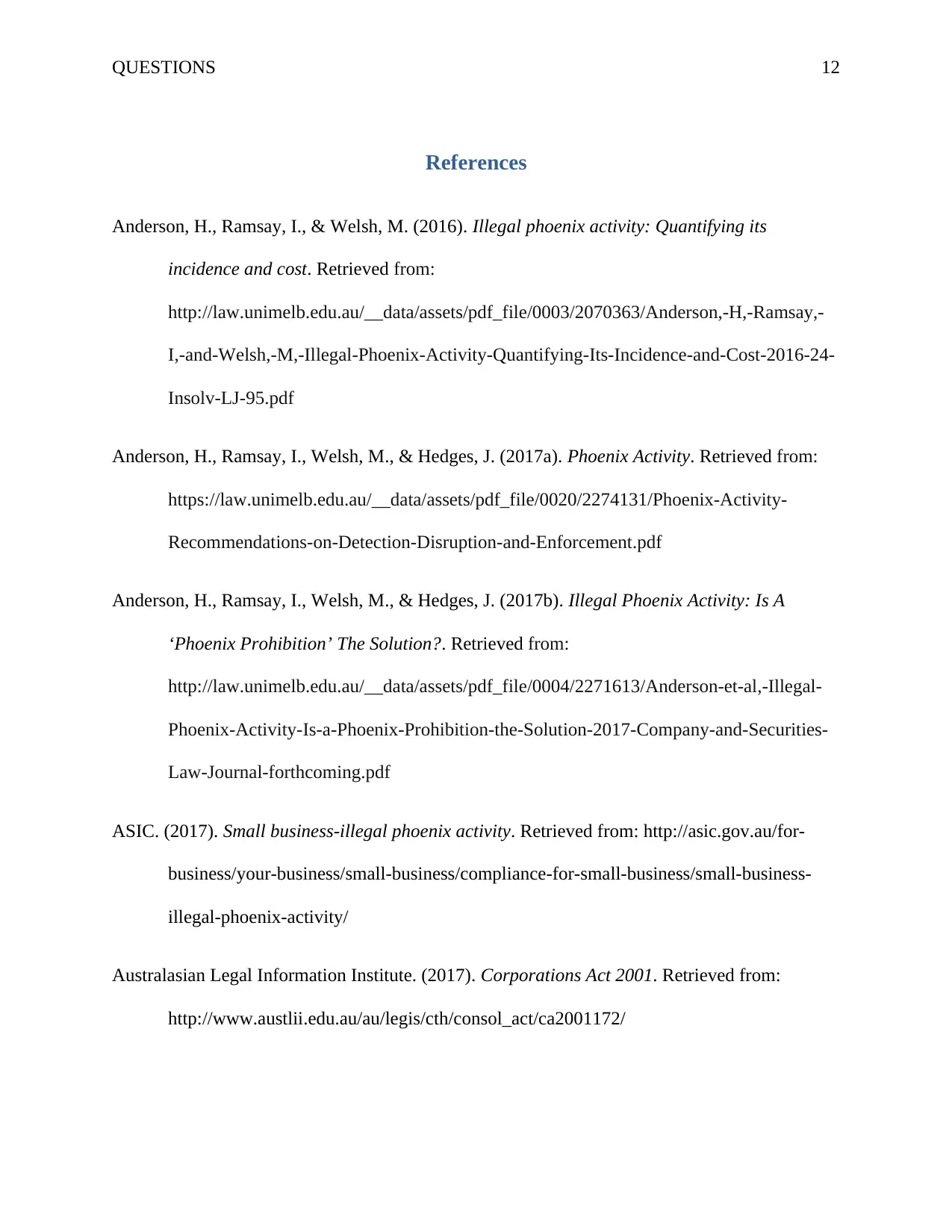
QUESTIONS 12
References
Anderson, H., Ramsay, I., & Welsh, M. (2016). Illegal phoenix activity: Quantifying its
incidence and cost. Retrieved from:
http://law.unimelb.edu.au/__data/assets/pdf_file/0003/2070363/Anderson,-H,-Ramsay,-
I,-and-Welsh,-M,-Illegal-Phoenix-Activity-Quantifying-Its-Incidence-and-Cost-2016-24-
Insolv-LJ-95.pdf
Anderson, H., Ramsay, I., Welsh, M., & Hedges, J. (2017a). Phoenix Activity. Retrieved from:
https://law.unimelb.edu.au/__data/assets/pdf_file/0020/2274131/Phoenix-Activity-
Recommendations-on-Detection-Disruption-and-Enforcement.pdf
Anderson, H., Ramsay, I., Welsh, M., & Hedges, J. (2017b). Illegal Phoenix Activity: Is A
‘Phoenix Prohibition’ The Solution?. Retrieved from:
http://law.unimelb.edu.au/__data/assets/pdf_file/0004/2271613/Anderson-et-al,-Illegal-
Phoenix-Activity-Is-a-Phoenix-Prohibition-the-Solution-2017-Company-and-Securities-
Law-Journal-forthcoming.pdf
ASIC. (2017). Small business-illegal phoenix activity. Retrieved from: http://asic.gov.au/for-
business/your-business/small-business/compliance-for-small-business/small-business-
illegal-phoenix-activity/
Australasian Legal Information Institute. (2017). Corporations Act 2001. Retrieved from:
http://www.austlii.edu.au/au/legis/cth/consol_act/ca2001172/
References
Anderson, H., Ramsay, I., & Welsh, M. (2016). Illegal phoenix activity: Quantifying its
incidence and cost. Retrieved from:
http://law.unimelb.edu.au/__data/assets/pdf_file/0003/2070363/Anderson,-H,-Ramsay,-
I,-and-Welsh,-M,-Illegal-Phoenix-Activity-Quantifying-Its-Incidence-and-Cost-2016-24-
Insolv-LJ-95.pdf
Anderson, H., Ramsay, I., Welsh, M., & Hedges, J. (2017a). Phoenix Activity. Retrieved from:
https://law.unimelb.edu.au/__data/assets/pdf_file/0020/2274131/Phoenix-Activity-
Recommendations-on-Detection-Disruption-and-Enforcement.pdf
Anderson, H., Ramsay, I., Welsh, M., & Hedges, J. (2017b). Illegal Phoenix Activity: Is A
‘Phoenix Prohibition’ The Solution?. Retrieved from:
http://law.unimelb.edu.au/__data/assets/pdf_file/0004/2271613/Anderson-et-al,-Illegal-
Phoenix-Activity-Is-a-Phoenix-Prohibition-the-Solution-2017-Company-and-Securities-
Law-Journal-forthcoming.pdf
ASIC. (2017). Small business-illegal phoenix activity. Retrieved from: http://asic.gov.au/for-
business/your-business/small-business/compliance-for-small-business/small-business-
illegal-phoenix-activity/
Australasian Legal Information Institute. (2017). Corporations Act 2001. Retrieved from:
http://www.austlii.edu.au/au/legis/cth/consol_act/ca2001172/
⊘ This is a preview!⊘
Do you want full access?
Subscribe today to unlock all pages.

Trusted by 1+ million students worldwide
1 out of 14
Related Documents
Your All-in-One AI-Powered Toolkit for Academic Success.
+13062052269
info@desklib.com
Available 24*7 on WhatsApp / Email
![[object Object]](/_next/static/media/star-bottom.7253800d.svg)
Unlock your academic potential
Copyright © 2020–2025 A2Z Services. All Rights Reserved. Developed and managed by ZUCOL.





